Cloud governance best practices for 2024
As your organization dives into cloud-based practices, cloud governance is your answer for increased data control and safety.
When you're designing a cloud governance plan, your organization's goals matter. Effective governance practices are based on your business needs, balancing your objectives while keeping your data secure.

After you've identified your needs, write a codified structure that outlines the best ways to keep information safe while helping your company perform at its best.
Table of contents:
- What is cloud governance?
- Why is cloud governance important?
- Challenges of cloud governances
- Best practices for 2022
- Don't set and forget
- Streamline cloud governance with cloud management software

What is cloud governance?
Cloud governance is a set of rules your company creates that dictates how you use the cloud, including access permissions, costs, and security. Governance helps your IT systems run smoothly so your company can increase its efficiency and use cloud systems to your advantage. Effective cloud governance practices help your business reap the full benefits of cloud computing while detecting and preventing compliance issues.
Moving your business operations to the cloud can save you time and money — but the shift requires a different approach to information security.
Cloud governance protects your company based on the data storage solutions you use. Creating detailed policies to address various issues helps your company use the cloud most effectively. Governance rules look different for every company, which is why it helps to tailor your policies to meet your business goals and match your users' needs.
The right actions and policies help your company succeed, but only if you implement them correctly and commit to seeing them through.
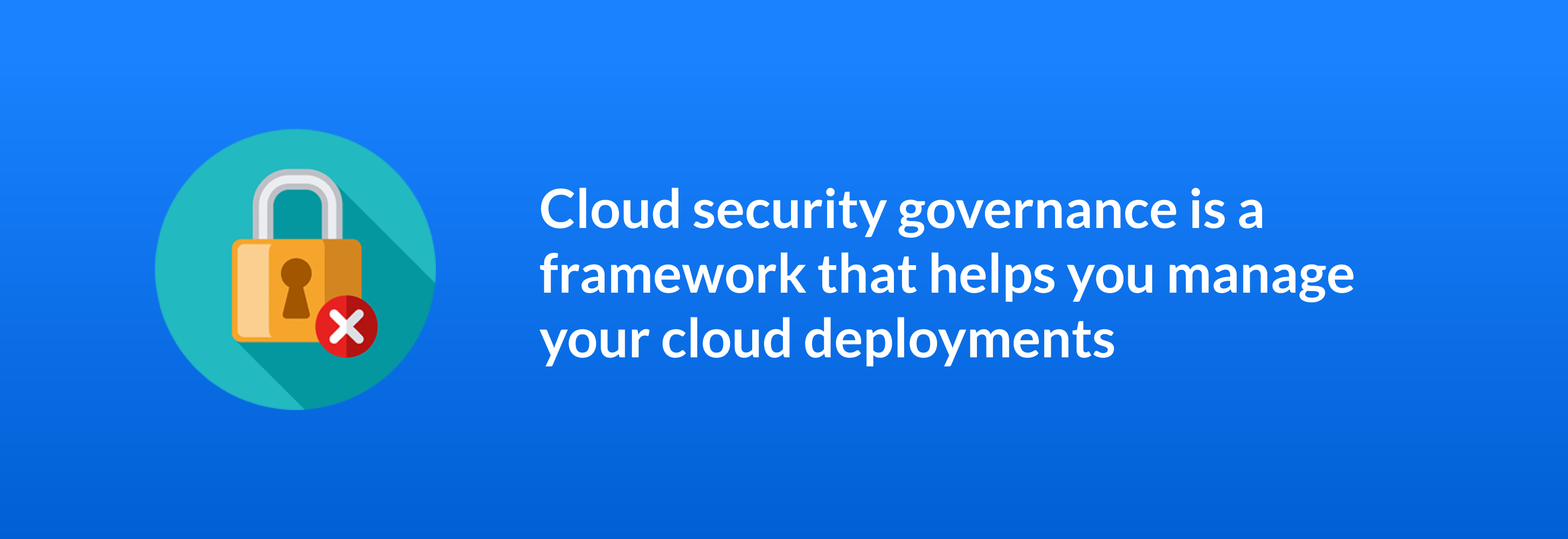
What is cloud security governance?
Your business can benefit from specific policies that create a more secure cloud experience. Cloud security governance is a type of cloud framework that focuses on effective security management rules specific to your business needs. Zooming in on security helps your company create strategies to manage risks and to keep data away from entities that might misuse or tamper with it.
A cloud security governance strategy helps your business achieve its larger goals. When you mitigate security risks without interfering with standard business operations, you reduce costs and increase productivity.
Why is cloud governance important?
Cloud governance is a crucial aspect of cloud computing. When all your business's information is in the cloud, you need a comprehensive way to track data activity, manage costs, and mitigate risks.
Governing cloud capabilities is important because cloud infrastructure is different from physical data infrastructure. Before the cloud came along, companies could store files in data centers and organize physical copies of information where it was less likely or impossible to be hacked remotely.
Physical infrastructure came with costs, though, such as storage capacity limits and slow methods of finding, sorting, and sending information. Cloud computing is the answer to many of these issues.
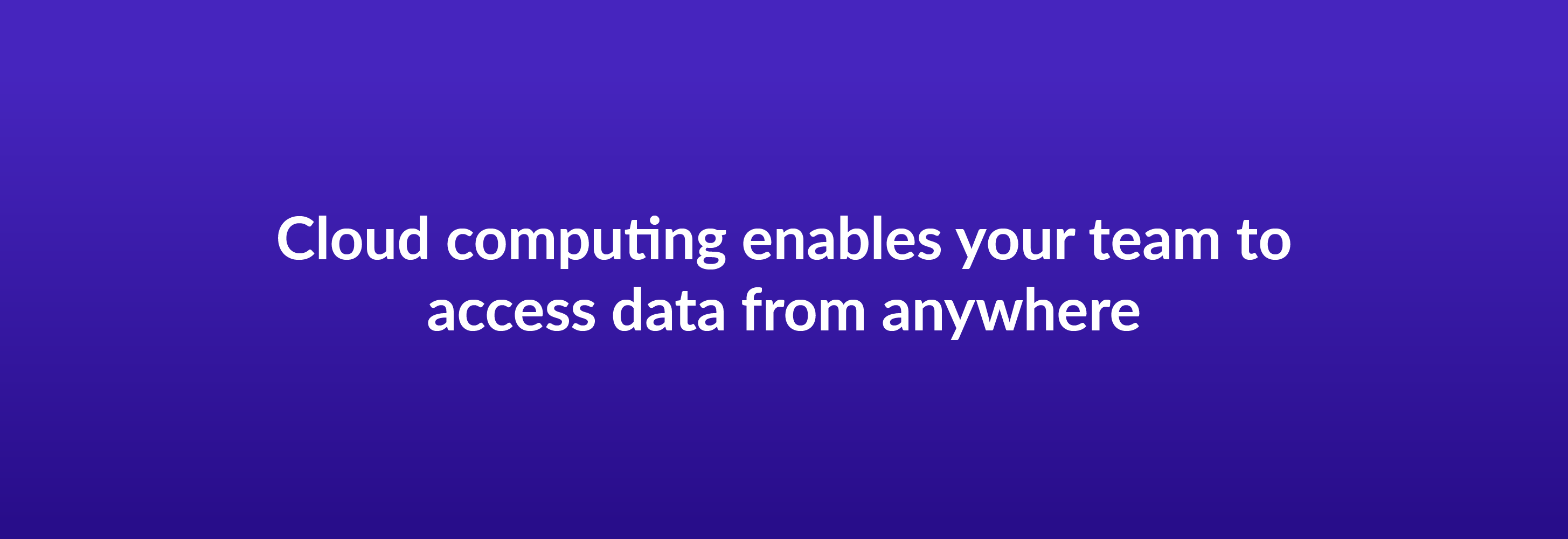
Benefits of cloud computing
Data stored in the cloud is instantly accessible by people around the world at any time. Virtually limitless storage capacities mean you'll always have space to secure all your files. Your business's entire data center can follow you wherever you go, making it easier than ever to access and share company information for easy communication and quick turnaround times.
Cloud-based infrastructure may even save your company upfront costs, as many cloud solutions only bill you for the resources you choose and actively use.
Cloud computing is different from physical data infrastructures, and maintenance strategies should be just as distinct. Traditional IT governance strategies no longer apply to cloud processes. Rather than setting up a single system that's effective on its own for a long time, cloud governance is characterized by constant maintenance to reflect the ever-changing realities of internet security and data capabilities.
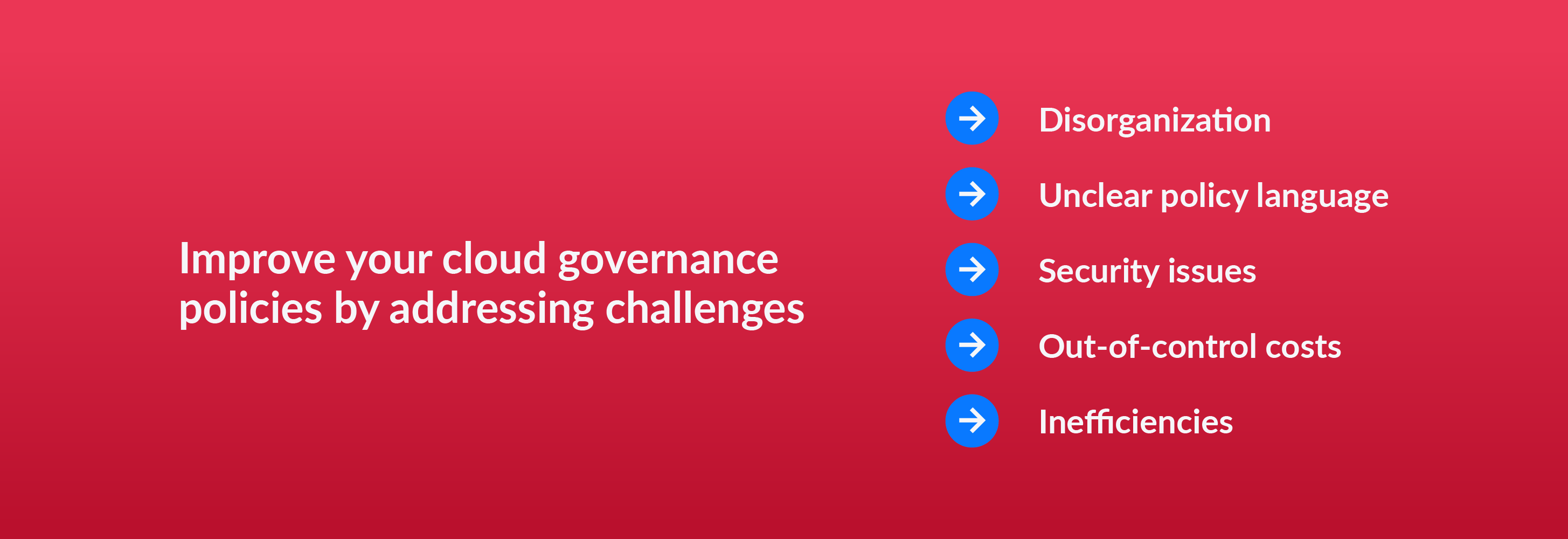
Challenges of cloud governance
When your company implements cloud security and governance, you'll want to make sure the measures you put in place provide security without hindering access to all the benefits your platform offers. Depending on the types of protection you need, cloud governance policies may still fall short of your requirements.
As your company creates its policies, keep in mind these cloud compliance and governance challenges to avoid:
1. Disorganization
Without physical components to keep track of, you may lose sight of where your data is stored or where people send it. Inaccurate file categories can lead to misplaced data or information-sharing capabilities that aren't secure enough. When you don’t have a handle on your content governance, it’s easy to slip up on compliance, too.
Neglecting to track what files you have and where they're located can cause issues down the line, including file duplication and version-control issues, as well as the general decrease in company productivity that results from struggling to find important information. Unauthorized people may also be able to access sensitive files if they aren’t labeled, organized, and protected well.
2. Unclear policy language
Cloud governance policies are most effective when they clearly lay out the rules and expectations for security and operations. However, policies can easily get bogged down with complicated content that doesn't accurately reflect your company goals or values. When this happens, employees, partners, and clients have a hard time knowing what rules to follow and how trustworthy your company is.
Additionally, unclear definitions and expectations can cause misunderstandings that result in practices not being upheld. When your business's executives aren't active members of the governance decision-making process, they may fail to include important rules or enforce certain policies.
3. Security issues
When companies fail to enforce or update their cloud governance policies in accordance with industry standards, they run the risk of creating compliance infractions. In addition, their cloud environments are more apt to encounter security issues like system vulnerabilities, data breaches, and access management oversights.
The cloud makes sharing information and permissions easy. While easy sharing can be helpful in some cases, it can also be dangerous. Many companies go too far with content sharing and give people access to data they don't actually need. Many businesses also don't keep track of when permissions should expire, leaving people with file access long after they stop working on a project or leave the company altogether.
The more people who have access to a file, the more vulnerable that file becomes. When the wrong people can access sensitive data, they're more likely to use it or share it without consideration for how it should be protected.
4. Out-of-control costs
While cloud governance is an important investment for your data security, watch for areas where you're spending more than you need to. When all your operations are conveniently stored in the cloud, you may lose track of certain processes.
Leaving applications running or buying more cloud storage than you need can increase your cloud bill if you're not careful.
5. Inefficiencies
Company-wide productivity is a top priority in any business. However, even when you have a governance plan in place, you might not make the best use of cloud services.
Many issues can contribute to cloud inefficiencies, including having a disorganized data structuring system and cluttering your workload with more services than you need. Not being strategic with the cloud services you use can mean you're missing out on opportunities to get more done in less time while keeping business operations secure.
Best practices for 2023
Data storage clouds are becoming increasingly sophisticated, which can help your company's information and operations stay secure as the tech industry expands. Today, cloud software is better than it's ever been. However, a more robust information storage platform requires increased planning and attention to detail to make sure you're keeping up with the most helpful solutions.
Following these cloud governance best practices will help you meet key compliance requirements while ensuring everyone has easy access to the resources they need.
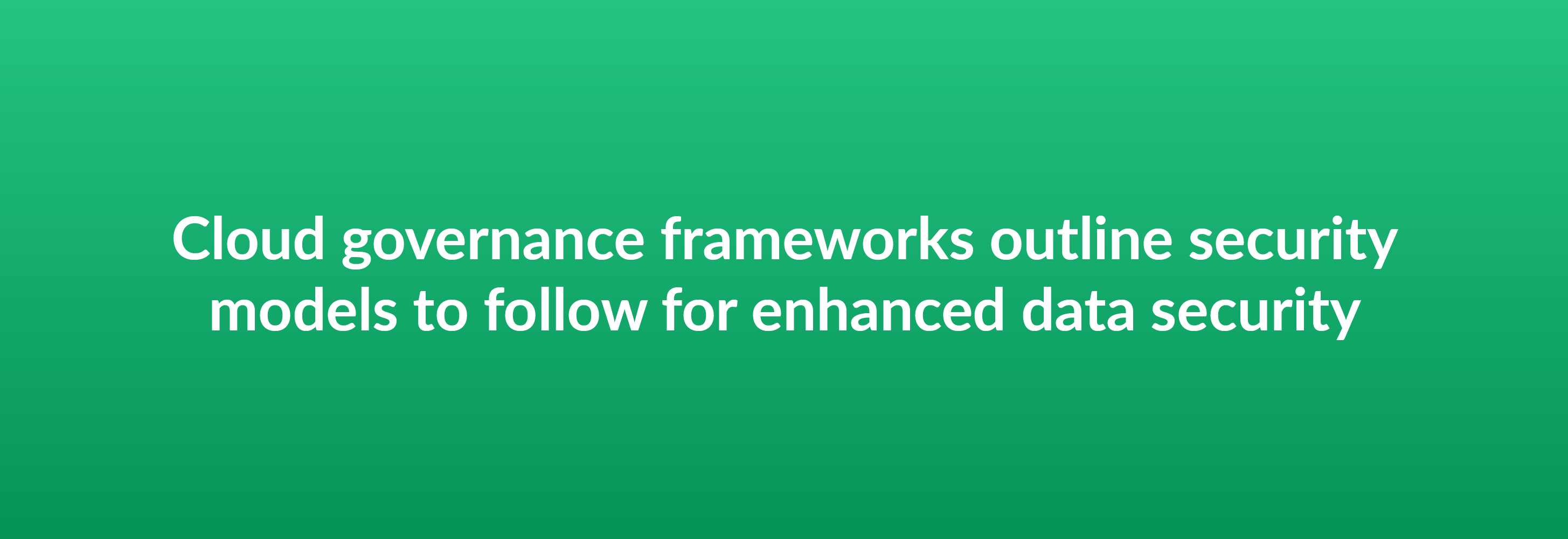
1. Establishing a framework
Cloud governance frameworks outline common security models to follow to achieve maximum data security. Frameworks communicate best practices for risk management in the cloud. They'll help you chronicle why you're using cloud resources and how you can improve your tactics to be more in line with industry or company goals. You can choose from several different frameworks based on your business needs.
While you'll want to create a more specialized governance plan for your specific company, starting with an established framework clarifies which goals to prioritize. Going forward, implementing a standardized approach to your cloud infrastructure will be easier and will help you keep up with company and cloud growth.
Depending on your industry and location, you may need to comply with certain frameworks to show you're doing everything you can to keep company and client information safe. Complying with certain well-known frameworks also helps you gain credibility, as potential clients or partners can easily see how you measure up to standards set to keep everyone's information secure.
2. Prioritizing compliance
Placing emphasis on maintaining compliance with important data security standards such as FedRAMP, HIPAA, and ISMAP is critical for effective cloud governance. In addition to making your organization more credible in the eyes of others in your industry, compliance also makes it easier to protect important client and company data.
Your cloud governance strategy should clearly define all the tools, processes, and individuals responsible for obtaining and maintaining compliance.
Here are some steps you can take to complete your compliance strategy:
- Implement a policy-as-code model: Program your security policies directly into your system's code, enabling it to automatically respond to security threats when they arise. To ensure these procedures are followed, you can also use an enforcement engine.
- Conduct frequent audits: Routinely auditing your security measures can help you ensure compliance with critical policies. You'll give your stakeholders confidence in your ability to keep their data secure with this measure. Be sure to include proper documentation, such as auditing procedures and retention or legal hold reports, to maintain compliance.
- Leverage cloud features: Take advantage of automation by opting in to the data governance features your cloud service provider offers. Automatic document purging, variable retention scheduling, granular controls around content deletion, and defensible discovery are all powerful capabilities that help make your cloud governance processes frictionless.
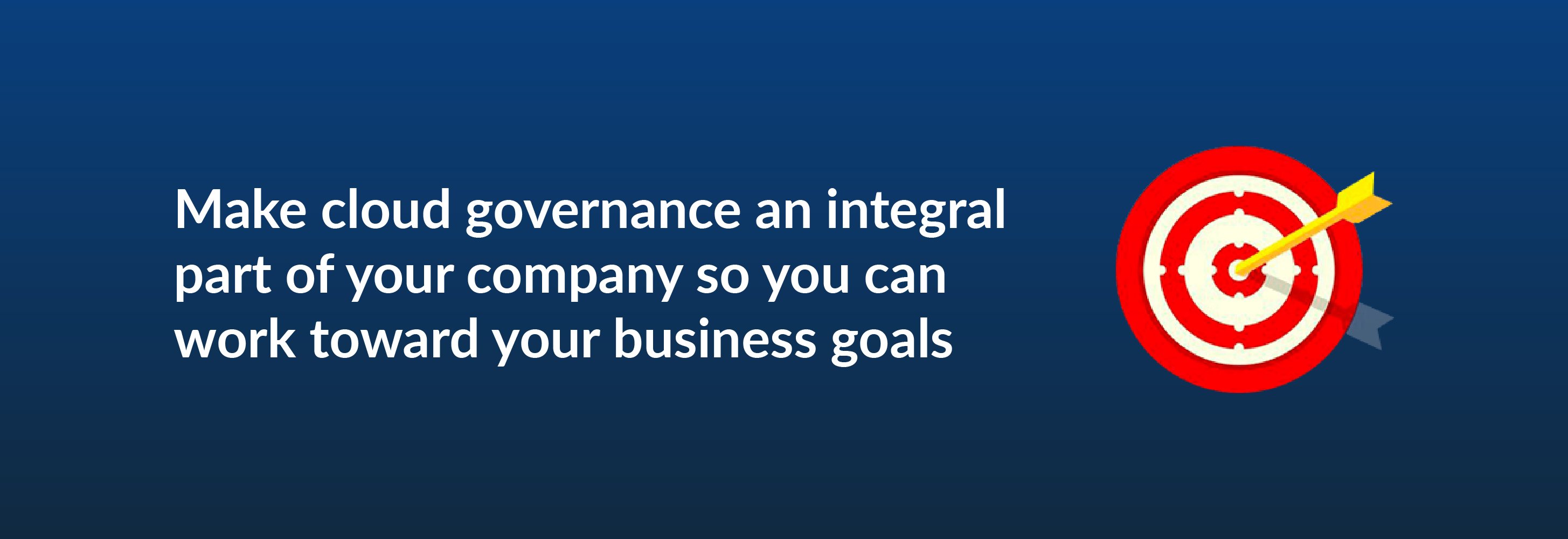
3. Aligning cloud infrastructure with business goals
Cloud services are most helpful when they align with your company's goals and values. As your company transitions to cloud solutions, map out your long-term business and financial goals. Once you have a concrete idea of where you want to be, you can implement cloud services that directly support those goals. Whatever industry you're in, putting your business model first lets you mold your cloud governance policies to fit your unique company trajectory and drive your success.
Cloud solutions are ever-evolving, so treat the cloud like the dynamic business partner it is. Clearly lay out how each business goal will affect your cloud usage now and in the future, and how any present or future cloud changes will impact your long-term plans.
As you work to align the cloud with your goals, make sure all your company's executives play a role in creating governance policies. The people in charge of your company should know exactly how the cloud aligns with their business trajectory so they can approve all policy decisions.
Your executives should then work together to write the policies in an authoritative, understandable tone. Clear language that aligns with business goals ensures everyone at your company knows how to adhere to cloud governance and how the policies will affect their work.
4. Implementing identity and access management
Once you know what data you have and where it's located, clarify who can and should have access to which files. Identity and access management helps you control who uses your data. User policies give your company set cloud governance rules to follow regarding who's allowed to see what data and how you'll protect against unauthorized access.
The best access management policy for your company will depend on how many employees and clients you govern. If your organization is relatively small, you may be able to use a cloud account management portal to set permissions and keep track of everyone's actions. For a larger organization, the user authentication processes might need to be more complex.
Tools like multi-factor authentication (MFA) are useful for ensuring people attempting to log in to your system are who they say they are. With MFA, people first enter their login credentials, then verify their identity by completing a task, such as:
- Responding to a push notification on their phone
- Answering a personal security question
- Swiping a physical key card
- Scanning their fingerprint
- Receiving a one-time password via email
Because malicious actors are unable to get past this second step, MFA protects your cloud environment against attacks from unauthorized people.
However you manage user access in your cloud systems, you'll need to set clear boundaries outlining what people are and aren't allowed to do with company data. Look at each role within your company and set authorizations and permissions according to what everyone needs.
You can also use automation and analytics to accurately monitor access permissions as your company grows and changes. Seeing how each person within your organization uses data lets you assess whether some of their permissions are unnecessary, and also clues you in on high-risk permissions you could scale back on.
Make sure individual or group access is limited to just the data and applications people need to do their jobs effectively. Over-permissioned identities are one of the top reasons for cloud vulnerabilities. Limiting access as much as possible allows for maximum security and productivity.
Revisit these permissions regularly and update them when necessary, such as when employees and clients come and go. New people need access to your systems so they can get to work right away. Meanwhile, people who no longer need to see company data should be taken off permissions lists to help prevent internal data breaches.
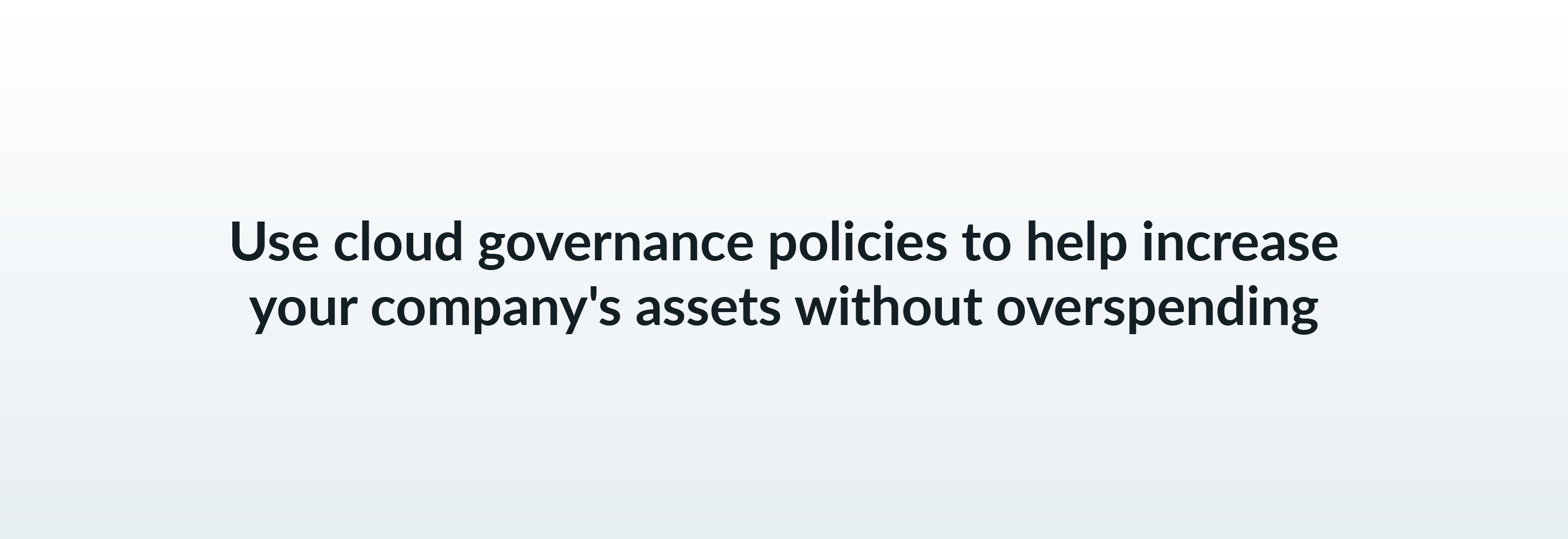
5. Managing costs
Tracking and analyzing how you spend money on cloud services is crucial to ensuring you use what you're paying for and get the most out of your investment. Cloud computing offers several options to aid your company's growth. However, you may find you're spending more money than you need on unnecessary components.
Effective cloud governance policies help your company increase its assets without spending too much. Regularly reviewing your cloud resources lets you see how you can streamline business activity by shutting down unused services and using necessary solutions more effectively.
Analytics help your business understand how all your departments and people use the cloud. This information will give you a better idea of which cloud features you need and which you could cut back on to save money. Analytics will also help you decide how to best use the resources you want to keep so you get the most out of what you're paying for.
Having a more specific cloud usage plan will ultimately drive productivity as your teams declutter your content platforms, making it easier to use the services to their fullest extent. Knowing your exact cloud costs can also help your company create a more accurate budget for tech expenses across the board.
6. Enabling automation
Automation is the act of applying technology to certain processes to improve speed, reliability, and efficiency while minimizing human intervention. Enabling automation in cloud computing services allows your company to avoid many instances of human error and accelerate your business activities.
Governance is a practical way for your company to enforce automation measures. Your cloud governance policies should clearly state what kinds of tools and processes your company will adopt to aid automation. When deciding these policies, consider company productivity and make sure any technology-based plans you implement will increase efficiency, solve existing issues, and make everyone's jobs easier.
Automating data storage and sharing processes can take many forms, depending on what your business goals are. For example, you may choose to leverage precise automation tools for monitoring and alerts or to implement databases and web servers that help everyone meet their goals faster. Automation is most effective when it allows for an autonomous workflow that decreases human error and increases efficiency across your company.
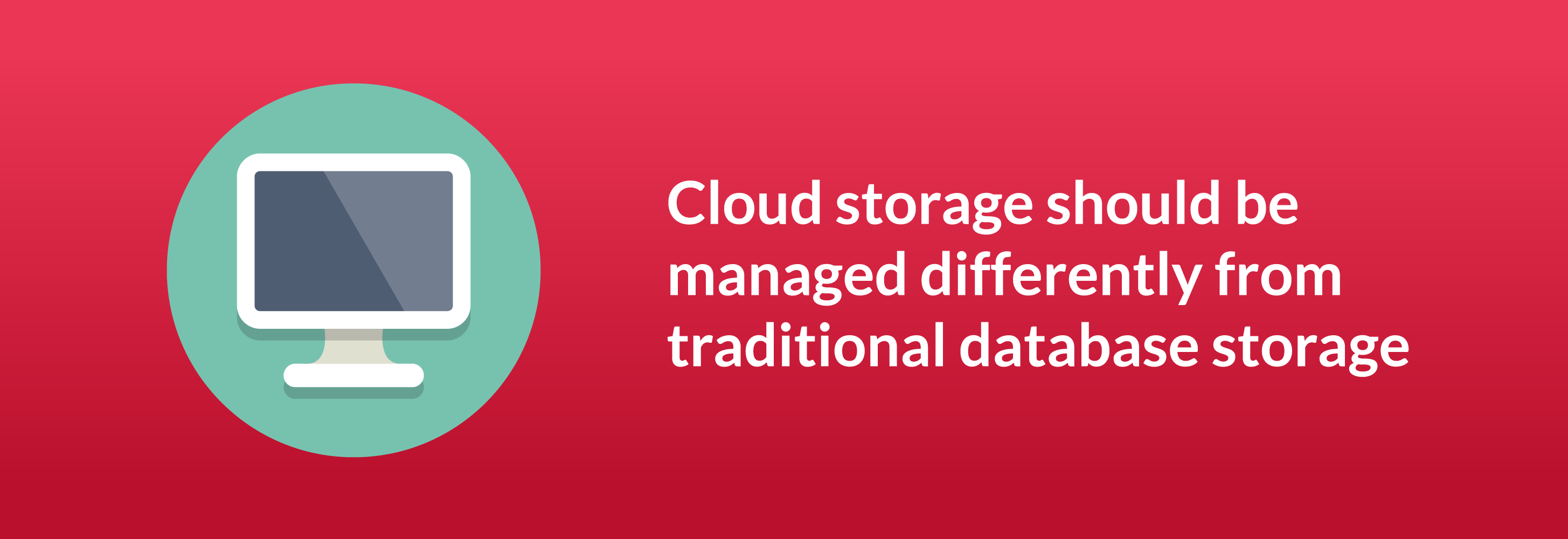
Don't set and forget
The most important practice your company can implement for your cloud service is periodically reviewing the governance policies you've established.
Before cloud storage, data protection and organization used to be self-contained within organizations' own databases. Individual data centers were, in many ways, easier to manage than the bigger, faster, constantly evolving cloud technologies companies use today. Often, you could set a governance plan and use it effectively for a long time without making changes.
Cloud systems need to be managed differently, as they provide more extensive protections. Features such as evolving permissions managements must be actively monitored so your company's data stays secure as your company expands. Otherwise, accidental or intentional security breaches could creep up and threaten your company's infrastructure.
Periodically review your rules and policies to make sure you're accounting for maximum security, organization, and cost savings while still letting users take full advantage of the cloud services you offer. You'll also want to adjust your cloud governance rules as your company grows, to make sure you maintain the same levels of protection and stability over time.
Discover the power of the Content Cloud
With a single secure platform for all your content, Box enables you to manage the entire content lifecycle: file creation, co-editing, sharing, e-signature, classification, retention, and so much more. We make it easy for you to collaborate on content with anyone, both inside and outside your organization. Frictionless, enterprise-grade security and compliance are built into our DNA, so you get total peace of mind that your content is protected. And with 1,500+ seamless integrations — as well as a range of native capabilities, like Box Sign — the Content Cloud provides a single content layer that ensures your teams can work the way they want.
The Content Cloud is a game changer for the entire organization, streamlining workflows and boosting productivity across every team. Contact us today, and explore what you can do with Box.
**While we maintain our steadfast commitment to offering products and services with best-in-class privacy, security, and compliance, the information provided in this blog post is not intended to constitute legal advice. We strongly encourage prospective and current customers to perform their own due diligence when assessing compliance with applicable laws.